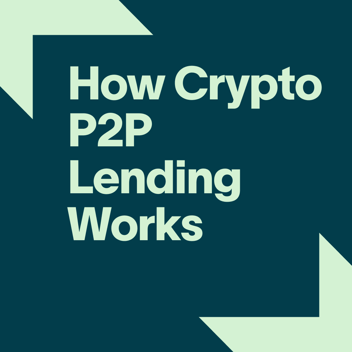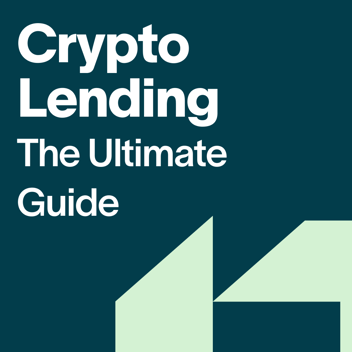USDC Staking - The Complete Guide

One of the most fascinating aspects of the crypto space is staking. This is a simple way that many people utilize as a method of making passive income. One very popular coin to stake is USD Coin, or USDC. But how exactly does USDC staking work, and is it more lucrative than simply placing it in a savings or growth account?
What Is USD Coin (USDC)?
USDC is one of the leading stablecoins in the cryptocurrency industry. It is a coin that is pegged to the price of the US dollar. This means that 1 USDC is equal to 1 US dollar. USDC is run by a company called Circle. To learn more about USDC, check out our ultimate guide on it here!
What Is USDC Staking?
USDC staking is the process of locking up your USDC tokens and lending them out to various platforms where you earn interest from them. This is different from staking in the conventional sense, which is where you participate in the consensus mechanism of a blockchain network, typically proof-of-stake, to validate transactions, secure the network, and in return, earn rewards in the form of the native cryptocurrency or token.
Rather, the term “USDC staking” is often used as a way of comparing this lending action to actual staking, the likes of which you see on truly proof-of-stake blockchains, like Ethereum and Polygon. Under the hood, they are very different things, but for the end user, they can be easily compared as they both offer reasonable forms of interest.
.png?width=1600&height=900&name=How%20to%20Earn%20Interest%20on%20USDC%20(1).png)
Pros and Cons of USDC Staking
Let’s delve further into the process of USDC staking, but looking at its pros and cons. This will help to frame our discussion.
Pros
Earn Passive Income: USDC staking is a way of earning passive income in a relatively simple way. It is a hands-off process, where you lock away your assets by passing them to another party, and they use it for the purposes of lending. Once you pass the assets over, you do not need to do anything else apart from wait. Your interest will accrue over time, and either be placed in the same wallet or account as your USDC is, or sent to you in another way.
Related Content: Best Ways to Earn Passive Income from Crypto in 2024
Increased Stability: Due to USDC being a stablecoin that is pegged to the US dollar, this means that the returns you make staking will stay at a consistent price-point. This is as opposed to staking something like Ethereum, where the rate can rapidly rise and fall throughout each day. Stablecoins help to offer some solace from such frustrations and complications.
Simple to Set Up: As USDC staking is not the same as conventional staking, this means there are significantly fewer steps to setting it up. For conventional staking, you often need to set up blockchain nodes, have your wallet synced up with those nodes, and participate with the network in some way. But with USDC, this is all avoided, as it does not include these technical elements. This makes it the perfect entry-point for beginners who want to look into gaining a passive income in the crypto world.
Cons
Now let’s take a look at some of the negatives of USDC staking, to balance out our guide.
Not The Same as Real Staking: It has been mentioned several times before, but USDC staking is not the same as conventional staking. Essentially, it is staking in name alone– it does not involve any activity related to upholding any blockchain, or facilitating transactions, or adding blocks to any chain. In its simplest form, it is just a term used to make it clear that users are able to make returns on their USDC for handing it over to another party. In truth, it is a technical mistake that people call it staking, as they really mean lending, in some way or another.
Related Content: Crypto Lending: The Ultimate Guide
Relies on Trusting Other Parties or Architecture: To stake USDC means to hand your assets over to another party, or to a decentralized system. In either case, you will be entrusting somebody or something else with your assets. If the staking provider is centralized, then you will be passing your assets to other humans. If it is decentralized, running on blockchain tech and smart contracts, then you will be relying on some type of digital architecture. Both options can pose some concerns, as trusting humans means you must evaluate the reputation, security measures, and financial stability of the platform or provider, and trusting architecture is a more extended and drawn out method of trusting humans, as they build the systems that you use. This means you're relying on the integrity of the code, the security of the smart contracts, and the absence of vulnerabilities, which if present, could be exploited, leading to potential loss of funds.
USDC Is Not As Widely Available as Other Stablecoins: While USDC could be considered a market leader in the stablecoin space, it is not the market leader. This title is attached to USDT (Tether), a rival stablecoin which is also pegged to the US dollar. USDT has existed for several years longer than USDC, and was a pioneer of the stablecoin space, helping it to cement its position among the crypto community. As a result, USDT is more widely available, with more tokens in circulation than USDC. For the most part, this will not affect USDC staking users, but it does mean that there is less supply and potentially less demand than USDT. To learn more about the difference between these two stablecoins, take a look at our comparison guide.
Is USDC Staking Legal?
USDC staking is generally considered legal. However, this will largely depend on the way you are staking, as well as the nations and jurisdictions that apply to you. In essence, USDC staking is simply the act of allocating USDC in a passive way, where another party or project uses it as a means of generating wealth. That being said, we are currently living in an age where crypto regulations are still being discovered and developed, and so nothing is static just yet.
While USDC staking is currently legal for the end user in many countries, regulators are in the process of examining the practices of both CeFi and DeFi services that offer this capability. In this sense, it is not so much a question of legality in the action itself, but more so an act of investigating the ways these projects actually offer returns. In several cases, regulators (especially in the West) have argued that some services are acting in underhanded or unfair ways. Connected to this is the current opinion of the US SEC, which considers many staking programs to be a type of security, and therefore requires official registration to occur for them to operate in the nation.
This could include unnecessary and suspicious uses of rehypothecation, which is where assets provided as collateral are used by a financial institution, such as a bank or a broker, for their own purposes—often for lending or investing. This can increase the risk for the original asset holder, especially if the institution faces solvency issues, since the same asset could be promised to multiple parties without them knowing.
It could also include instances where some services engage in poor risk management activity, or do not have the end-user’s best interests at heart. In these cases, legality is not exactly related to the person engaging in USDC staking, but rather the staking providers themselves.
That being said, some countries are vehemently against the use of cryptocurrency as a whole. This includes nations such as North Korea, Bangladesh, Bolivia, Nepal, and Morocco, among others, where they have either banned crypto activities outright or have taken a very restrictive stance on its usage and trading. It's always crucial to stay updated with local regulations, as the landscape can change rapidly.
There are also regions that support cryptocurrency, but may frown upon the act of earning interest. A strong example of this is with Islamic nations that adhere to Sharia law. One of the primary principles of Islamic finance is riba, or usury. This is where there is an unjustified increase in wealth in the form of interest. Riba is forbidden in Sharia law because it is considered exploitative by nature and leads to unjust enrichment and unnecessary profit.
The prohibition aims to ensure that both parties in a transaction have a clear and equitable understanding of terms and that wealth is generated through legitimate trade and investment, rather than through exploitative or deceptive means. This is in line with the broader Islamic principles of fairness, transparency, and justice. It is hard to say with certainty whether USDC staking would fit into this category, as Sharia law was developed in a time when cryptocurrency never existed, and so connecting the two concepts can lead to a range of different interpretations.
This naturally makes for a highly complicated situation; one where there is no one direct and definitive answer. In truth, it is up to interpretation. With this in mind, it is best to consult the documentation and legal reasoning which relates directly to your jurisdiction.
Best USDC Staking Platform
Let’s take a look at some of the top USDC staking platforms on the market.
AAVE
AAVE is a decentralized lending service, open to everybody to use around the world. It offers USDC staking, although it does not refer to it under this name. Rather, it speaks about it in the context of supplying more USDC to its liquidity pools. At the time of writing, the APY for doing this is 2.97%.
Related Content: Aave vs Compound: DeFi Lending Comparison
Kraken
Kraken is a leading centralized crypto exchange. While it is mostly known for spot trading, it does have its own staking and lending applications attached to it, where it supports USDC. Here, you can earn 3.75% APY on your USDC holdings, if you stake them and lock them up on Kraken’s platform.
ByBit
Like Kraken, ByBit is also a centralized cryptocurrency exchange with some staking and lending capabilities. However, unlike Kraken, ByBit does not provide these services itself– rather, it functions as a staking aggregate. For USDC, it lists staking via Curve (offering 4.50% APR) and ApeX Pro (offering 15.86% APY). These are both decentralized projects.
To learn more about some of these services, take a look at our ultimate guide to crypto lending.
Is Staking USDC Safe?
As with many aspects of the crypto landscape, USDC staking is only as safe as the project or company you’re working with. So, if you are working with a service that has a good track record, works hard to be regulations-compliant, and treats your assets with the respect and seriousness it deserves, then it could be considered relatively safe.
However, finding a project that does this can be extremely hard, and in an age where many services have faced legal troubles in the past (or have even become insolvent) this can be troublesome. With this in mind, it may make sense to take a more sensible approach, and look for a USDC savings account, such as Ledn’s Growth Accounts.
With Ledn, you can place your USDC in one of their safe and secure Growth Accounts, where you can currently make up to 8.50% APY returns on your assets. Not only is this a highly competitive rate for the market, but Ledn has a strong reputation for being regulations-compliant, as well as having strong risk management protocols. One huge part of this is that Ledn acts with radical transparency, where users can look at our proof-of-reserves data, showing our dedication to openness and mutual respect for its clients. This is something that can be hard to find with USDC staking services.
Can you lose funds Staking USDC?
It is definitely possible to lose funds when it comes to USDC staking. While staking is generally considered a low-risk activity, this usually refers to staking in the conventional sense, where you lock your digital assets away in a wallet via decentralized means, as a way of upholding a blockchain network. As we’ve discussed earlier, USDC staking is not the same as this, and is rather an imitation of this.
The easiest way you can lose funds via this method is if the service you use becomes insolvent (if it is a centralized company), or its smart contracts get hacked or exploited (if it is a decentralized service). The best alternative to something like this would be to use Ledn’s Growth Accounts, which are legally ring fenced, meaning that you only face the counterparties that generate your interest and any Ledn insolvency risk is removed.
Related Content: Best USDC Interest Rates for Passive Income
Best USDC Staking Alternatives
With this in mind, it is worth looking into USDC staking alternatives that can help generate wealth. As has been mentioned, savings or growth accounts are a great way of making a return on your USDC, both in the short and long term. Another alternative would be to simply invest in the form of trading. As USDC is a stablecoin, you cannot hold it and expect gains in the same way you can with coins like Bitcoin or Ethereum, but you can always exchange it for these cryptocurrencies and hope that the markets rest in your favor.
Of course, activity like this is inherently risky, as the crypto markets are notoriously unpredictable. But it is an alternative, regardless. It is also worth considering more traditional alternatives, such as holding fiat US dollars in a regular savings account, such as those offered by banks and building societies. However, these are not available to everybody. If you live in a country where US dollars are hard to obtain, such as developing nations or countries that have conflicts with the US, then this might not be a possibility.
Plus, if you are unbanked or underbanked, meaning that traditional financial organizations do not cater to your needs or are inaccessible to you, then relying on conventional banking services might not be feasible. This is where cryptocurrencies, and more specifically USDC staking, can fill a significant void, providing an avenue for financial inclusion and a potential avenue for savings and growth. It offers a digital, borderless way of participating in the global economy, without the barriers that conventional banking systems often impose on marginalized communities.
Conclusion
USDC staking is both a simple and multi-faceted process. In one sense, it is easy to “stake” USDC by finding a service which lets you earn rewards and returns, but in another sense, finding the right service is extremely hard, and requires a lot of research and initiative.
For this reason, many people prefer to use alternative methods, such as USDC savings accounts. This includes Ledn’s Growth Accounts, which adhere to a range of safety and risk management protocols, provided by a company that works hard to offer transparency and reliability. Not only this, but with up to 8.50% APY interest, their Growth Accounts currently offer a highly competitive return rate, compared to USDC staking services on the market.
That being said, it makes sense to think hard about what type of project you want to work with, and what you value most in a service. Take a look at the projects on the market at the moment– for help navigating this, make sure to check out our ultimate guide to crypto lending, as many of the services listed also work with USDC.
Sponsored by 21 Technologies Inc. and its affiliates (“Ledn”). All reviews and opinions expressed are based on my personal views.




